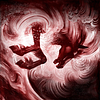Take a photo of a barcode or cover
A childhood favorite of mine such a strong young woman and such an inspiration great story I read an elementary school 40 years ago and I remember it
Wow! This is certainly a classic for a reason. There are definitely some problematic elements here, not the least of which is the use of the term "Eskimo," so it shows its age. However, there's so much beauty and quality wrapped up in this package. First off, George's training as a naturalist is very apparent; her descriptions of wolf behavior and the arctic seasons are incredible. Also, Miyax is a powerful character, and I love that George doesn't shy away from depicting the brutality of human nature through this female character in addition to her kindness. The ending for me was unsatisfying, if realistic; she addresses the Westernization of colonized peoples pretty well, although of course I just wanted to see Miyax . Of course, this story is also just a top-notch "going-into-the-wild" adventure story. Overall, it is a book I'd encourage any child to read.
Spoiler
take off on her own for good
This book is quite dated, and it bothers me that it uses the word "Eskimo" instead of "Inuit." I haven't read this book since I was a kid (I prefer the 3rd book in the trilogy, [b:Julie's Wolf Pack|122482|Julie's Wolf Pack (Julie of the Wolves, #3)|Jean Craighead George|https://images.gr-assets.com/books/1388253453s/122482.jpg|819489] but last month I got the audiobook and my husband, 10 year old son and I all listened to it together while we were driving places. My husband said he enjoyed it a lot and my son got mad at me a few times for stopping the audiobook when we reached our destination. The ending nearly gutted him just like I remember it doing to me when I was his age. So now my family shares my pain, and things are good.
A reminder of what the world was like to live in Nature and with nature.
It took me a while to read this and it had little to do with the story and mostly to do with time. I'm so glad I finally read this story. I find this story to be quite powerful and the message of living in balance with nature is quite a powerful theme and call. Julie has knowledge of how to survive in the wilderness. That knowledge is so valuable. People should make money by letting people pay to come for a week or two and learn to survive on the land and appreciate the world around them.
Julie was married off to a family that didn't quite work out for her. It was not good. So, she decides to run away. She runs off over the tundra of the Northern world and finds a wolf pack that takes her in. Julie is smart and knows how to read wolves. She survives on the plains with the wolves. The best part of the story is when she is living with the wolves and learning from them.
Jean is an amazing writer and she obviously knows about survival skills. She wrote My side of the Mountain and that was all about surviving in the wilderness as well. She can spin a good yarn outdoors for certain. Her books are incredible.
The pace is a little slower than today, but I found it very engaging and interesting. There is a flashback to Julie living with that family she marries into and that was the place I got stuck for so long. That part dragged, but the parts she is outside were amazing. This is similar to Hatchet in some ways.
Jean does use the word Eskimo and the book is written in 1972 when that was accepted, but I recently learned that they consider that a slur and prefer to be called something else like Inuit. That was news to me, but apparently, now they really hate that word. It is used a lot in this story.
I did enjoy this and it is worth reading, in my opinion. I love nature, but I am not suited to live in nature any longer. I can't drag around a library out there. I love living close to nature with plumbing and yet, I still found this book very powerful and a great read.
It took me a while to read this and it had little to do with the story and mostly to do with time. I'm so glad I finally read this story. I find this story to be quite powerful and the message of living in balance with nature is quite a powerful theme and call. Julie has knowledge of how to survive in the wilderness. That knowledge is so valuable. People should make money by letting people pay to come for a week or two and learn to survive on the land and appreciate the world around them.
Julie was married off to a family that didn't quite work out for her. It was not good. So, she decides to run away. She runs off over the tundra of the Northern world and finds a wolf pack that takes her in. Julie is smart and knows how to read wolves. She survives on the plains with the wolves. The best part of the story is when she is living with the wolves and learning from them.
Jean is an amazing writer and she obviously knows about survival skills. She wrote My side of the Mountain and that was all about surviving in the wilderness as well. She can spin a good yarn outdoors for certain. Her books are incredible.
The pace is a little slower than today, but I found it very engaging and interesting. There is a flashback to Julie living with that family she marries into and that was the place I got stuck for so long. That part dragged, but the parts she is outside were amazing. This is similar to Hatchet in some ways.
Jean does use the word Eskimo and the book is written in 1972 when that was accepted, but I recently learned that they consider that a slur and prefer to be called something else like Inuit. That was news to me, but apparently, now they really hate that word. It is used a lot in this story.
I did enjoy this and it is worth reading, in my opinion. I love nature, but I am not suited to live in nature any longer. I can't drag around a library out there. I love living close to nature with plumbing and yet, I still found this book very powerful and a great read.
adventurous
inspiring
lighthearted
medium-paced
Plot or Character Driven:
Character
Strong character development:
Yes
Loveable characters:
Yes
Diverse cast of characters:
Yes
Flaws of characters a main focus:
Complicated
"When fear seizes, change what you are doing. You are doing something wrong."
Actual rating: 3.5 stars, rounded up.
When I was 9 years old, I picked up Hatchet for the first time, because all of the boys in my class were obsessed with it. I immediately shared their obsession and had to find anything else that featured a young person surviving alone in the wild. I read the rest of Brian’s Saga, and The Island of the Blue Dolphins, and My Side of the Mountain and the books that followed. I also read this book and the rest of the trilogy. I haven’t read Julie of the Wolves in over 20 years, and I didn’t remember nearly as much about it as I thought it did. Which made it a fun story to revisit.
I’ve always had a soft spot for any story that takes place in Alaska, so I especially loved the setting of this particular series. Julie, or Miyax, as she prefers to go by her Eskimo name, is a great character. I love that our protagonist is a very capable female, which isn’t as common in this small subgenre of children’s novels. However, I had completely forgotten how much sadness there was in this story, and that there was a scene involving a near rape. I’m often surprised when I revisit a children’s classic by the content that I don’t recall, that obviously didn’t bother me when I was a child. Which, in my opinion, is an argument for why we shouldn’t ban books to protect our kids. The vast majority of the things we’re worried about either won’t bother the children we are trying to protect, or will lead them to asking big, and very important questions.
This was a refreshing revisit, and I loved my time with Miyax and the wolf pack that becomes her family. There’s nothing like a children’s classic when you’re needing a mental palette cleanser.
When I was 9 years old, I picked up Hatchet for the first time, because all of the boys in my class were obsessed with it. I immediately shared their obsession and had to find anything else that featured a young person surviving alone in the wild. I read the rest of Brian’s Saga, and The Island of the Blue Dolphins, and My Side of the Mountain and the books that followed. I also read this book and the rest of the trilogy. I haven’t read Julie of the Wolves in over 20 years, and I didn’t remember nearly as much about it as I thought it did. Which made it a fun story to revisit.
I’ve always had a soft spot for any story that takes place in Alaska, so I especially loved the setting of this particular series. Julie, or Miyax, as she prefers to go by her Eskimo name, is a great character. I love that our protagonist is a very capable female, which isn’t as common in this small subgenre of children’s novels. However, I had completely forgotten how much sadness there was in this story, and that there was a scene involving a near rape. I’m often surprised when I revisit a children’s classic by the content that I don’t recall, that obviously didn’t bother me when I was a child. Which, in my opinion, is an argument for why we shouldn’t ban books to protect our kids. The vast majority of the things we’re worried about either won’t bother the children we are trying to protect, or will lead them to asking big, and very important questions.
This was a refreshing revisit, and I loved my time with Miyax and the wolf pack that becomes her family. There’s nothing like a children’s classic when you’re needing a mental palette cleanser.
Jean Craighead George always writes the best nature stories. For me, nothing will ever come close to My Side of the Mountain, but Julie of the Wolves has many of the same aspects that make me love her writing. Be aware this was written in 1972 and uses the slur Esk*mo throughout the book, instead of the more accurate Inuit.
It took a while to get through this, just because we were reading it at bedtime. Lily reading liked it. She lives stories about the Arctic, and about animals, and survival stories. So this was great. I really enjoyed the writing and the beautiful descriptions. Lily really wants me to get the next book.






